MORPHEMIC STRUCTURE OF THE WORD 2
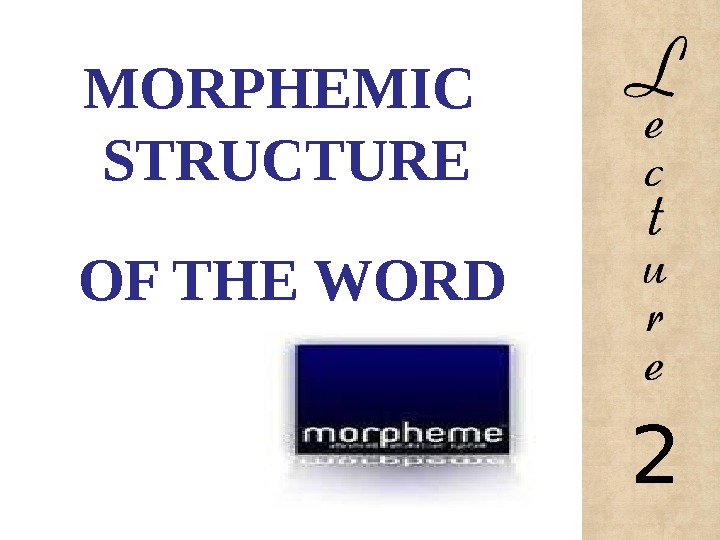
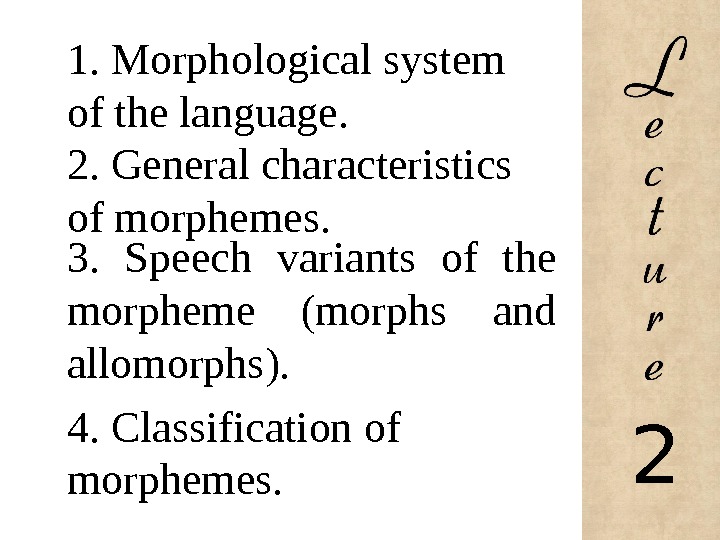


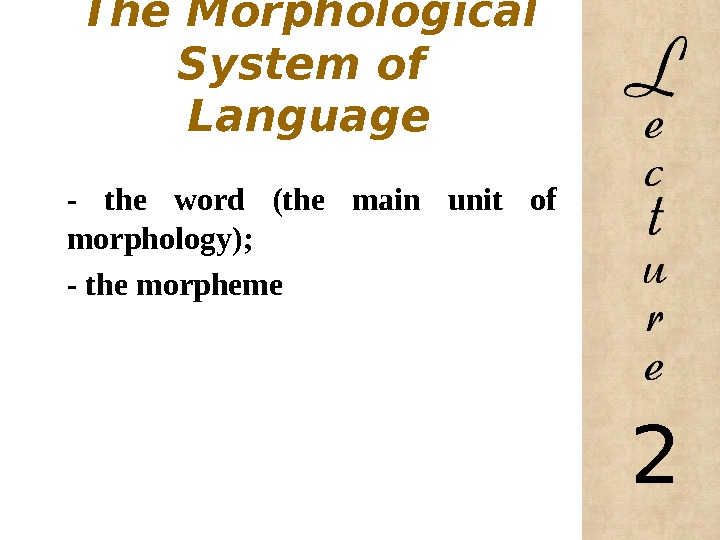







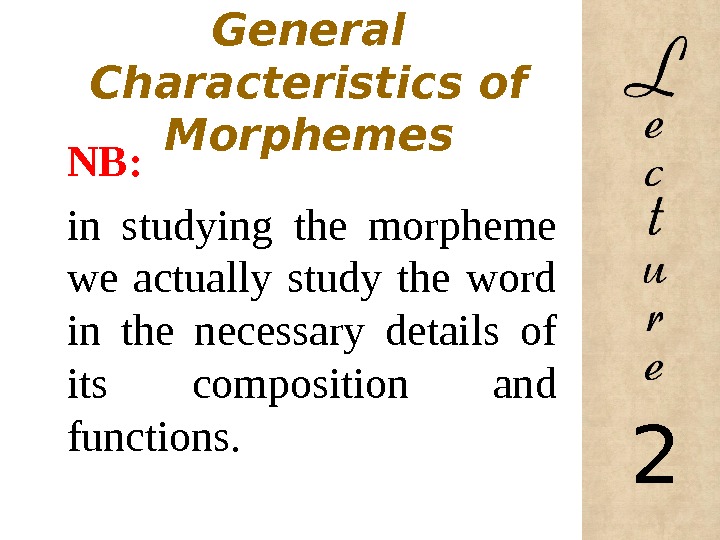

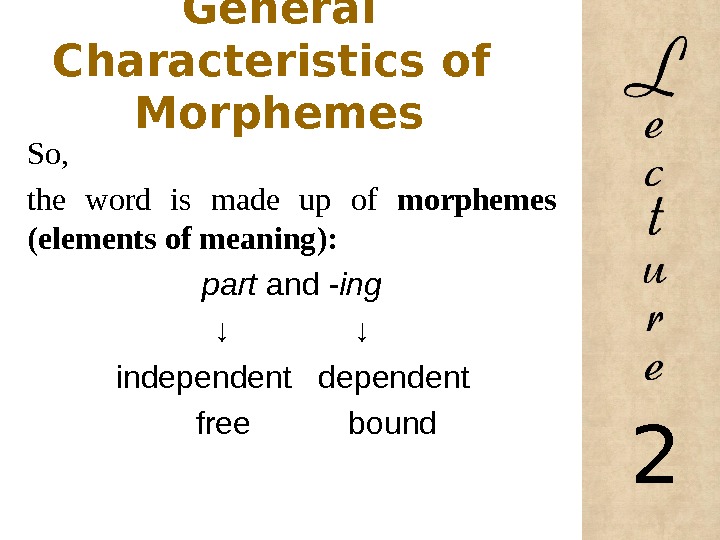
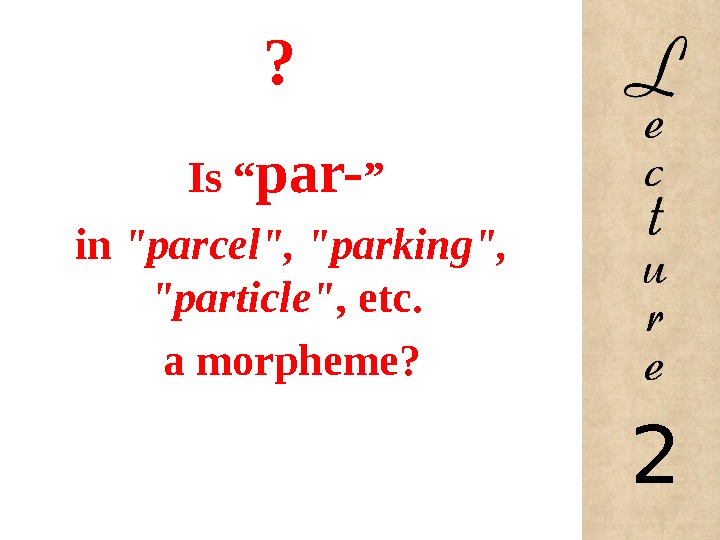
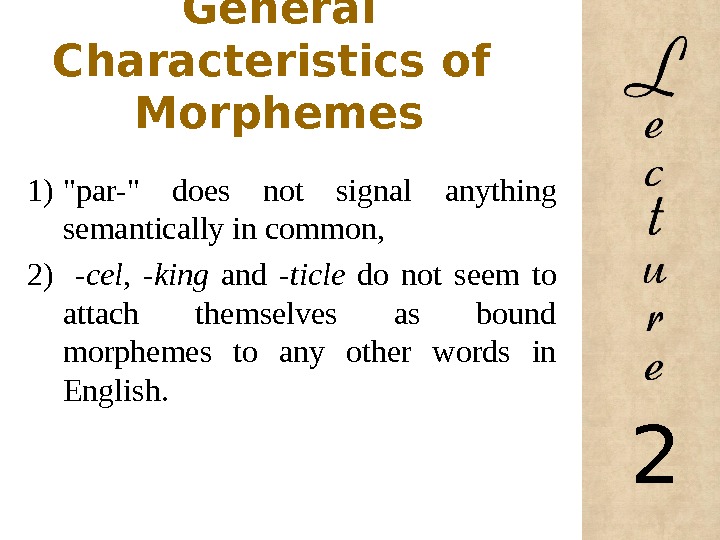

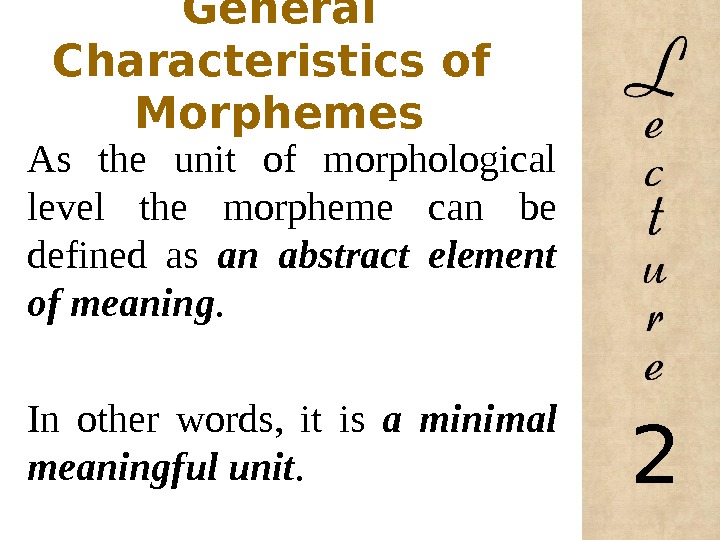


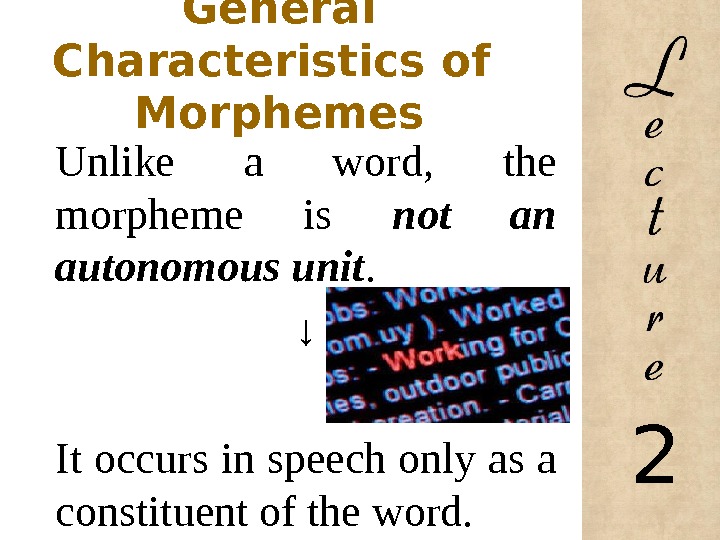
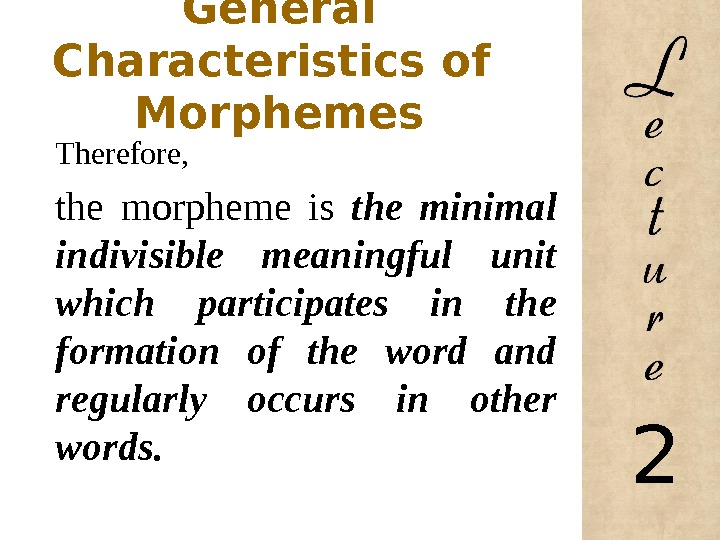



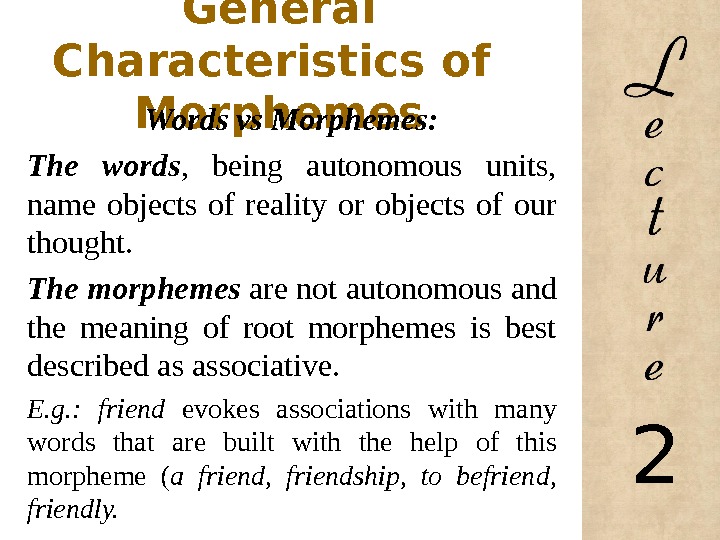
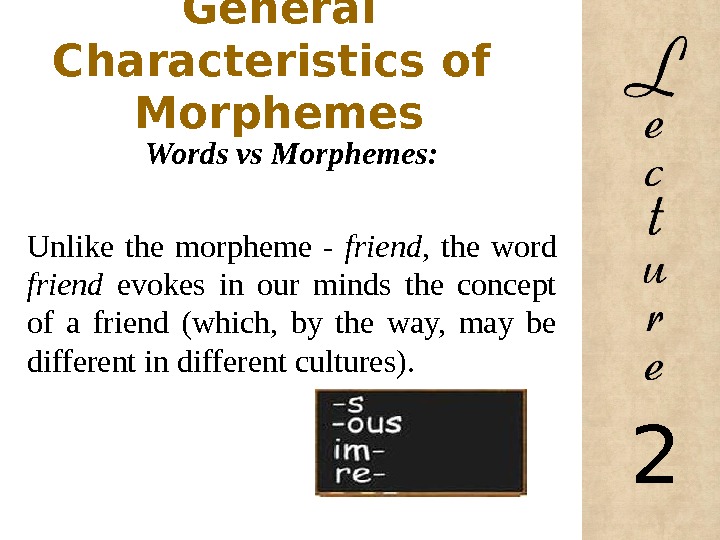
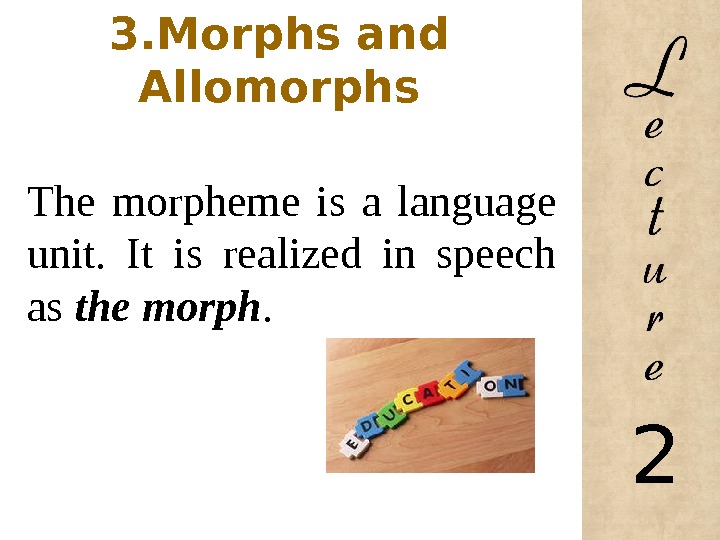

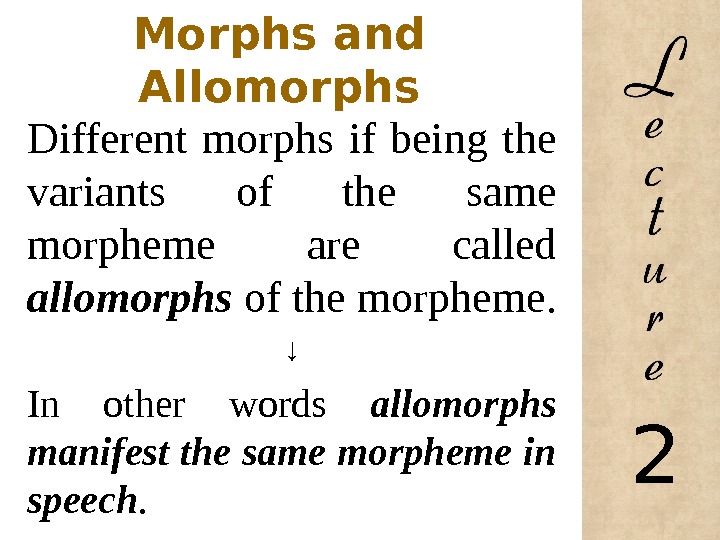
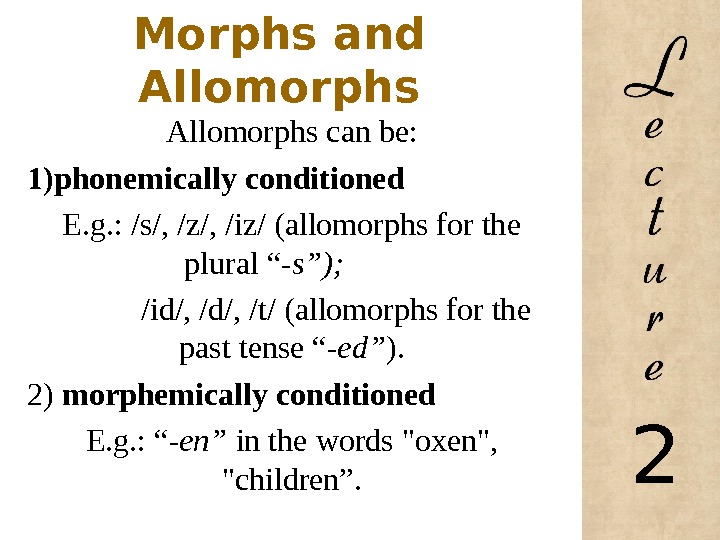

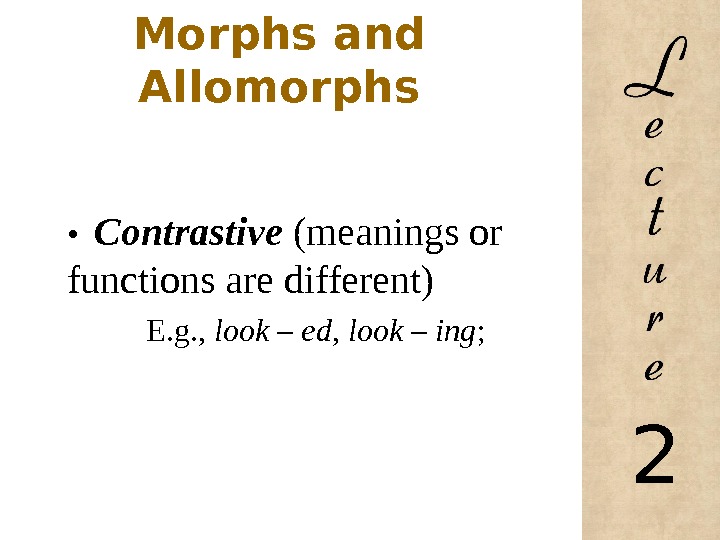

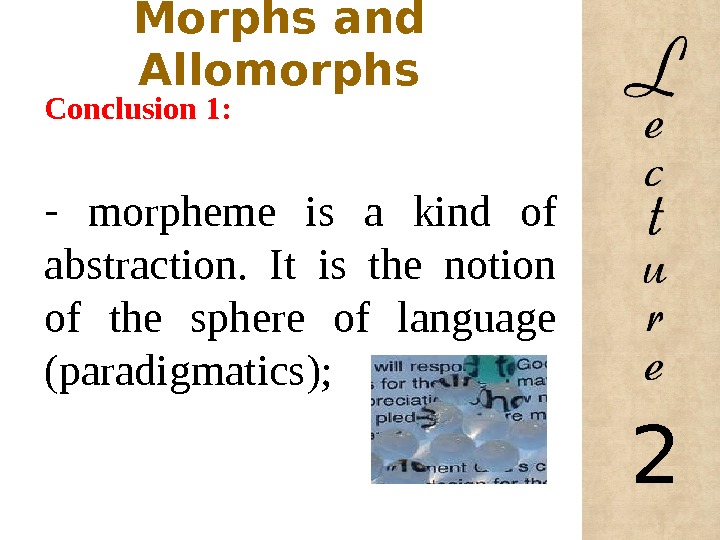
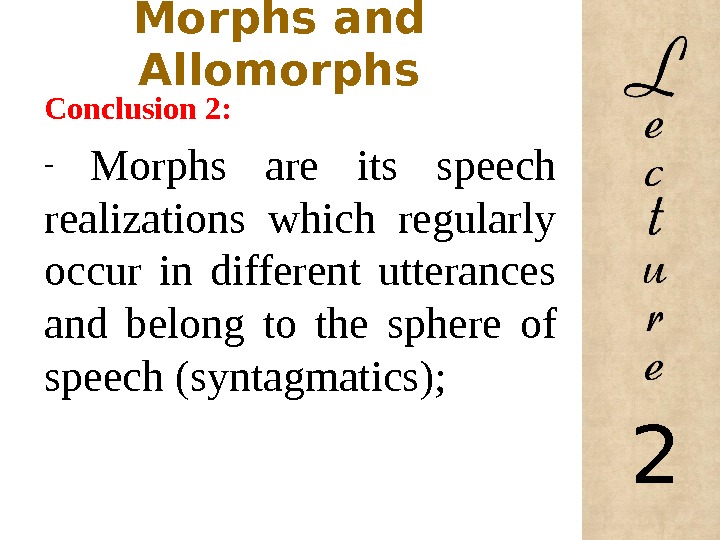


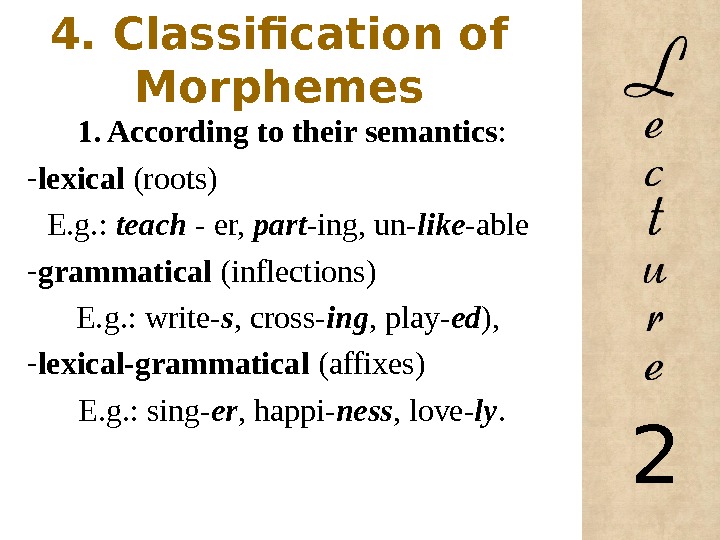

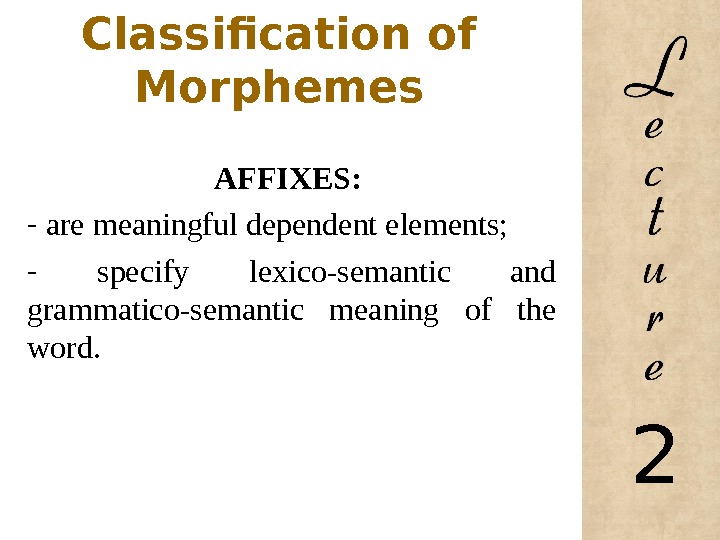
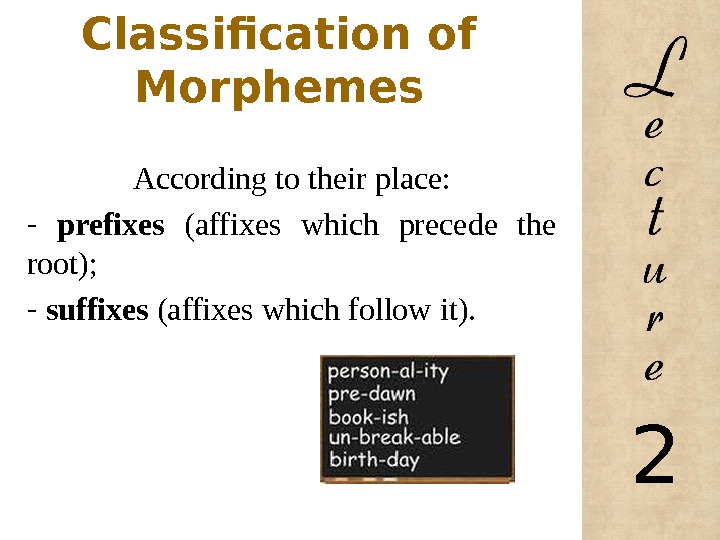
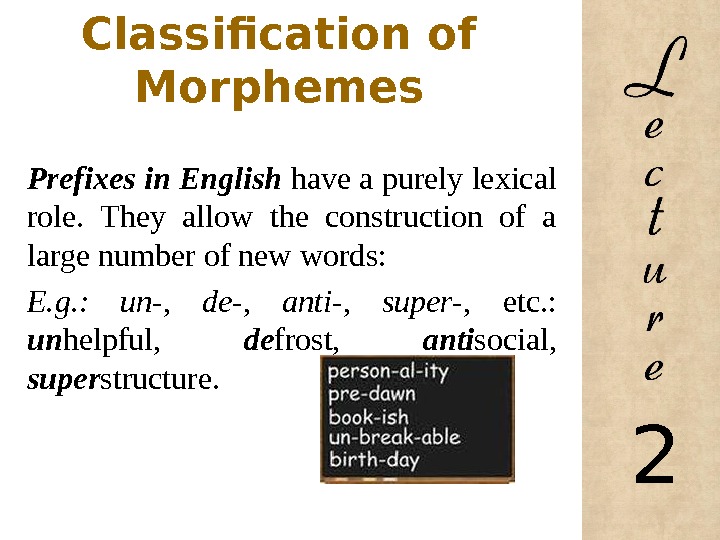


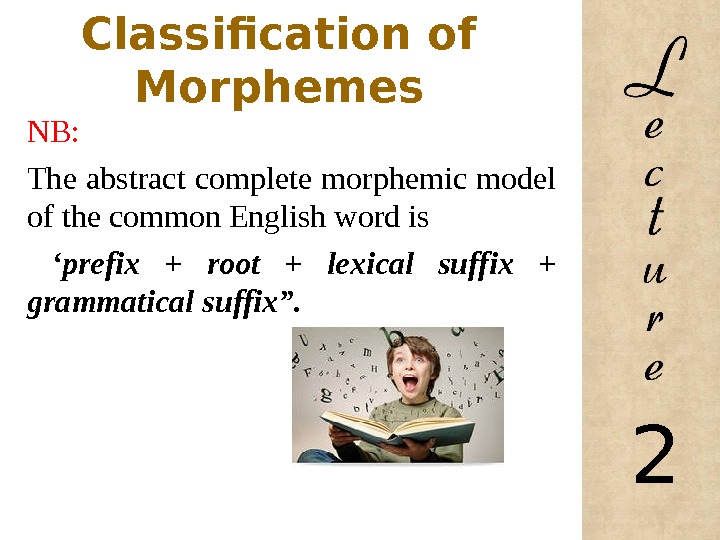
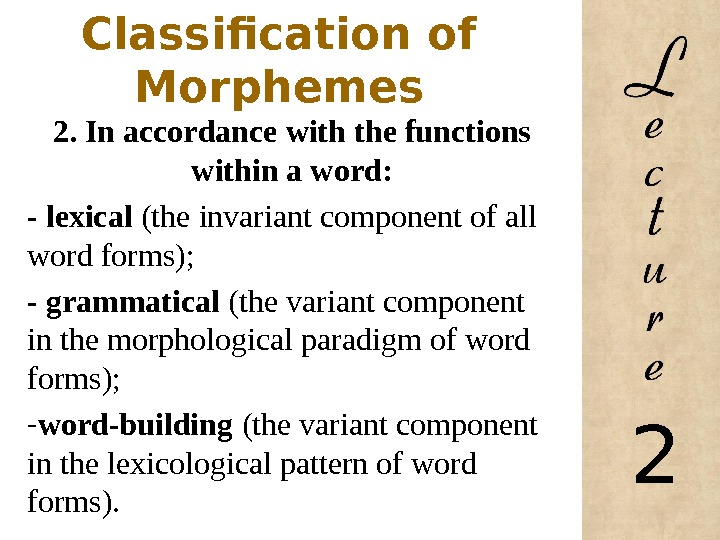

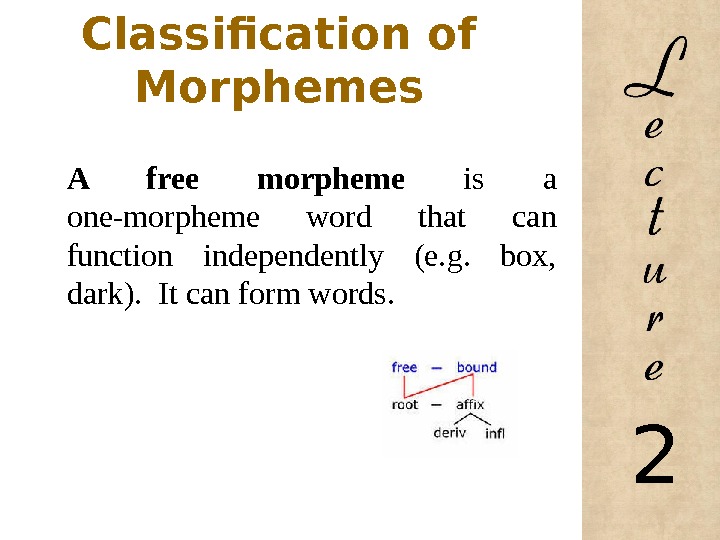
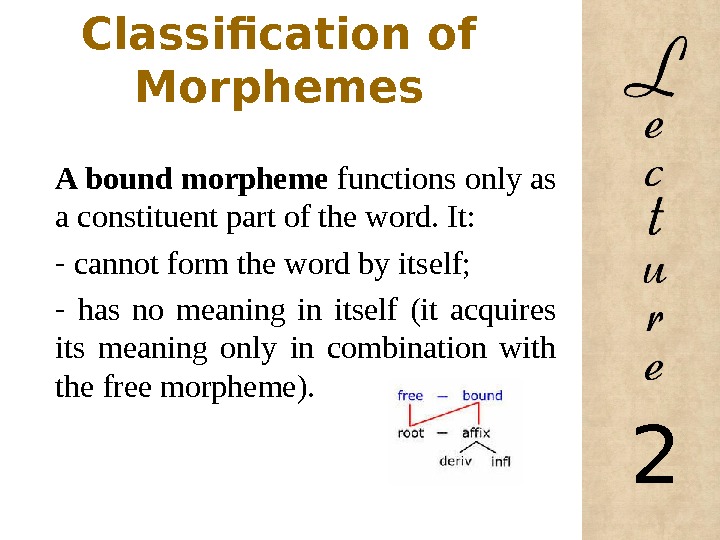
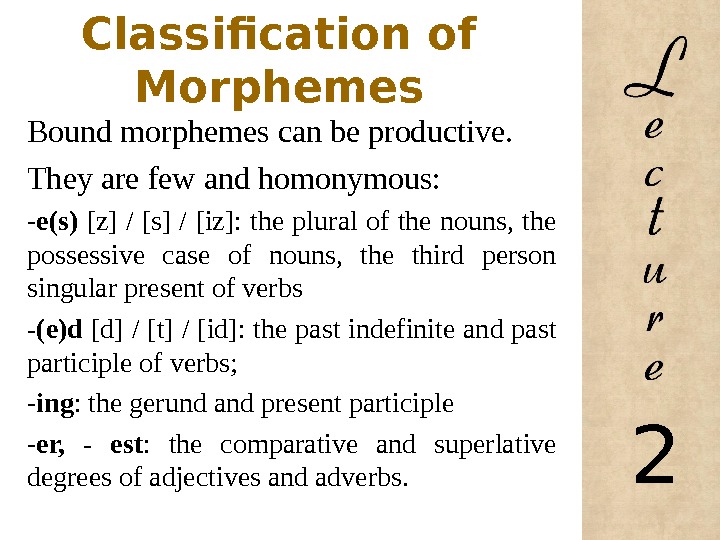
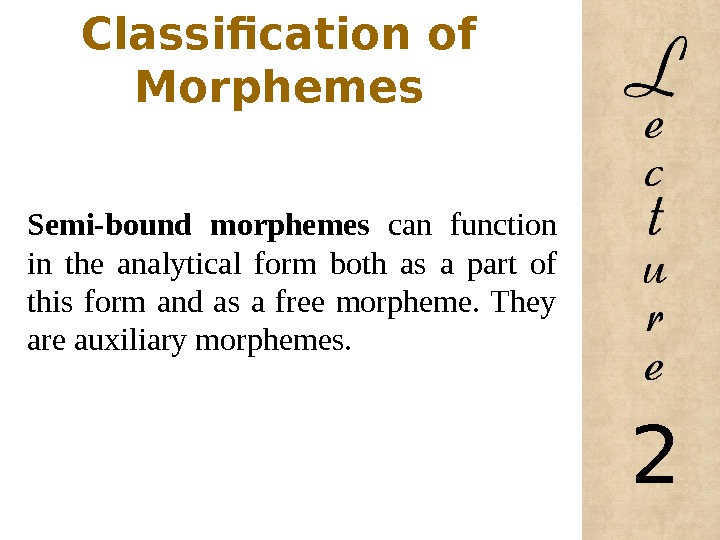



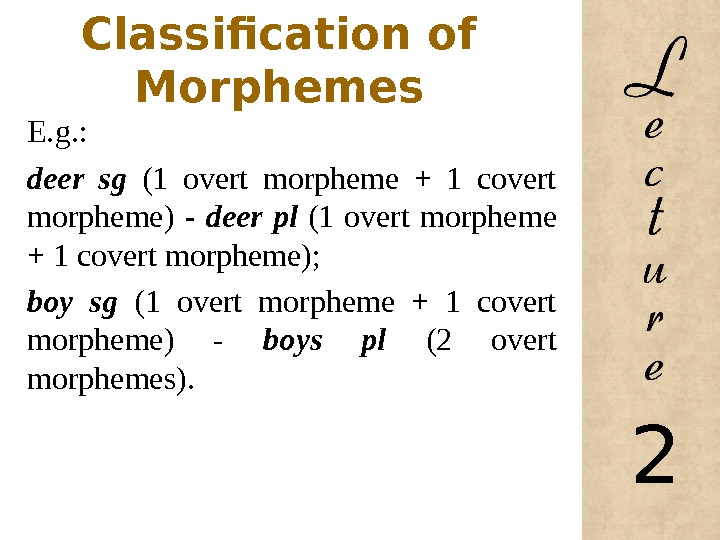






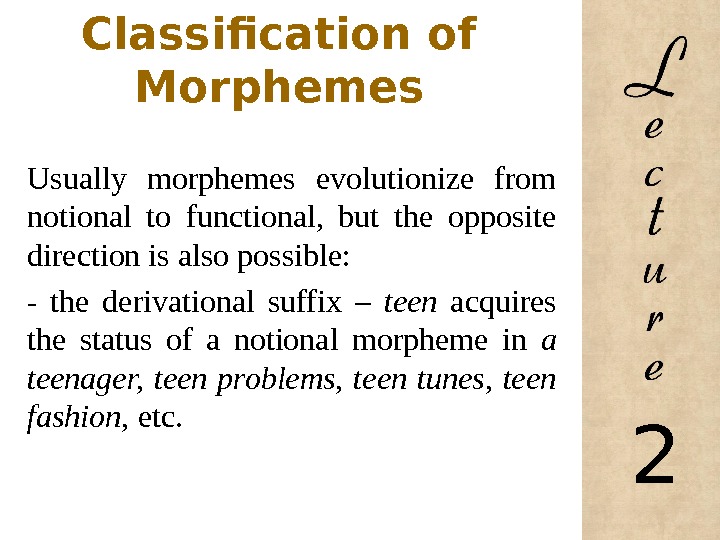

- Размер: 1.4 Mегабайта
- Количество слайдов: 65
Описание презентации MORPHEMIC STRUCTURE OF THE WORD 2 по слайдам
 MORPHEMIC STRUCTURE OF THE WOR
MORPHEMIC STRUCTURE OF THE WOR
 1. Morphological system of the language. 2. General characteristics of morphemes. 3. Speech variants of the morpheme (morphs and allomorphs). 4. Classification of morphemes.
1. Morphological system of the language. 2. General characteristics of morphemes. 3. Speech variants of the morpheme (morphs and allomorphs). 4. Classification of morphemes.
 1. The Morphological System of Language The morphological system of language reveals its properties through the morphemic structure of words.
1. The Morphological System of Language The morphological system of language reveals its properties through the morphemic structure of words.
 ? What are the units of morphology?
? What are the units of morphology?
 The Morphological System of Language — the word (the main unit of morphology); — the morpheme
The Morphological System of Language — the word (the main unit of morphology); — the morpheme
 ? What do you know about the word?
? What do you know about the word?
 The Morphological System of Language The WORD is: — a basic nominative unit; — an elementary indivisible constituent part of the lexicon; — communication means.
The Morphological System of Language The WORD is: — a basic nominative unit; — an elementary indivisible constituent part of the lexicon; — communication means.
 The Morphological System of Language According to Prof. Blokh (Ch. II § 2), The WORD is: — a basic nominative unit of language formed by morphemes;
The Morphological System of Language According to Prof. Blokh (Ch. II § 2), The WORD is: — a basic nominative unit of language formed by morphemes;
 The Morphological System of Language — elementary component of the lexicon (i. e. a component indivisible into smaller segments as regards its nominative function);
The Morphological System of Language — elementary component of the lexicon (i. e. a component indivisible into smaller segments as regards its nominative function);
 The Morphological System of Language — used for the formation of the sentence (= a unit of information in the communication process).
The Morphological System of Language — used for the formation of the sentence (= a unit of information in the communication process).
 2. General Characteristics of Morphemes What is a morpheme?
2. General Characteristics of Morphemes What is a morpheme?
 General Characteristics of Morphemes are significative components of words, their elementary meaningful parts.
General Characteristics of Morphemes are significative components of words, their elementary meaningful parts.
 General Characteristics of Morphemes NB: in studying the morpheme we actually study the word in the necessary details of its composition and functions.
General Characteristics of Morphemes NB: in studying the morpheme we actually study the word in the necessary details of its composition and functions.
 General Characteristics of Morphemes The meaning of words can be defined in terms of: — syllables E. g. par-ty, par-ting — morphemes E. g. party, part-ing (*par-ting) meet-ing pass-ing
General Characteristics of Morphemes The meaning of words can be defined in terms of: — syllables E. g. par-ty, par-ting — morphemes E. g. party, part-ing (*par-ting) meet-ing pass-ing
 General Characteristics of Morphemes So, the word is made up of morphemes (elements of meaning): part and -ing ↓ independent free bound
General Characteristics of Morphemes So, the word is made up of morphemes (elements of meaning): part and -ing ↓ independent free bound
 ? Is “ par- ” in «parcel», «parking», «particle» , etc. a morpheme?
? Is “ par- ” in «parcel», «parking», «particle» , etc. a morpheme?
 General Characteristics of Morphemes 1) «par-» does not signal anything semantically in common, 2) -cel, -king and -ticle do not seem to attach themselves as bound morphemes to any other words in English.
General Characteristics of Morphemes 1) «par-» does not signal anything semantically in common, 2) -cel, -king and -ticle do not seem to attach themselves as bound morphemes to any other words in English.
 General Characteristics of Morphemes NB: in English the syllable as a unit of sound has no correspondence with the morpheme as a unit of meaning — » party » (2 syllables, 1 morpheme); — » parting » (2 syllables, 2 morphemes).
General Characteristics of Morphemes NB: in English the syllable as a unit of sound has no correspondence with the morpheme as a unit of meaning — » party » (2 syllables, 1 morpheme); — » parting » (2 syllables, 2 morphemes).
 General Characteristics of Morphemes As the unit of morphological level the morpheme can be defined as an abstract element of meaning. In other words, it is a minimal meaningful unit.
General Characteristics of Morphemes As the unit of morphological level the morpheme can be defined as an abstract element of meaning. In other words, it is a minimal meaningful unit.
 General Characteristics of Morphemes As all other language units morphemes are twofold signs which have: — the plane of content ; — the plane of expression.
General Characteristics of Morphemes As all other language units morphemes are twofold signs which have: — the plane of content ; — the plane of expression.
 General Characteristics of Morphemes In the hierarchy of meaningful language units (the word, the word-group, the sentence and the text) the morpheme can be described as the minimal and indivisible unit : it cannot be segmented further without losing its constitutive essence, that is, the meaning of a definite form. E. g. : -ed ≠ e and d
General Characteristics of Morphemes In the hierarchy of meaningful language units (the word, the word-group, the sentence and the text) the morpheme can be described as the minimal and indivisible unit : it cannot be segmented further without losing its constitutive essence, that is, the meaning of a definite form. E. g. : -ed ≠ e and d
 General Characteristics of Morphemes Unlike a word, the morpheme is not an autonomous unit. ↓ It occurs in speech only as a constituent of the word.
General Characteristics of Morphemes Unlike a word, the morpheme is not an autonomous unit. ↓ It occurs in speech only as a constituent of the word.
 General Characteristics of Morphemes Therefore, the morpheme is the minimal indivisible meaningful unit which participates in the formation of the word and regularly occurs in other words.
General Characteristics of Morphemes Therefore, the morpheme is the minimal indivisible meaningful unit which participates in the formation of the word and regularly occurs in other words.
 General Characteristics of Morphemes According to Prof. Blokh (Ch. II § 2) the MORPHEME is: — meaningful segmental component of the word (expresses abstract, «significative» meanings, used as constituents for the formation of more concrete, «nominative» meanings of words);
General Characteristics of Morphemes According to Prof. Blokh (Ch. II § 2) the MORPHEME is: — meaningful segmental component of the word (expresses abstract, «significative» meanings, used as constituents for the formation of more concrete, «nominative» meanings of words);
 General Characteristics of Morphemes — formed by phonemes (the shortest morphemes include only one phoneme) E. g. : cos-y [-i]; a-blaze [ -]; enter-s [-z]); ә
General Characteristics of Morphemes — formed by phonemes (the shortest morphemes include only one phoneme) E. g. : cos-y [-i]; a-blaze [ -]; enter-s [-z]); ә
 General Characteristics of Morphemes — elementary component of the word (i. e. indivisible into smaller segments as regards its significative function).
General Characteristics of Morphemes — elementary component of the word (i. e. indivisible into smaller segments as regards its significative function).
 General Characteristics of Morphemes Words vs Morphemes: The words , being autonomous units, name objects of reality or objects of our thought. The morphemes are not autonomous and the meaning of root morphemes is best described as associative. E. g. : friend evokes associations with many words that are built with the help of this morpheme ( a friend, friendship, to befriend, friendly.
General Characteristics of Morphemes Words vs Morphemes: The words , being autonomous units, name objects of reality or objects of our thought. The morphemes are not autonomous and the meaning of root morphemes is best described as associative. E. g. : friend evokes associations with many words that are built with the help of this morpheme ( a friend, friendship, to befriend, friendly.
 General Characteristics of Morphemes Words vs Morphemes: Unlike the morpheme — friend, the word friend evokes in our minds the concept of a friend (which, by the way, may be different in different cultures).
General Characteristics of Morphemes Words vs Morphemes: Unlike the morpheme — friend, the word friend evokes in our minds the concept of a friend (which, by the way, may be different in different cultures).
 3. Morphs and Allomorphs The morpheme is a language unit. It is realized in speech as the morph.
3. Morphs and Allomorphs The morpheme is a language unit. It is realized in speech as the morph.
 Morphs and Allomorphs Morphs are the smallest meaningful successions of phonemes into which words are broken up. E. g. : paint , paint — s , paint — ed , paint — ing , paint — er
Morphs and Allomorphs Morphs are the smallest meaningful successions of phonemes into which words are broken up. E. g. : paint , paint — s , paint — ed , paint — ing , paint — er
 Morphs and Allomorphs Different morphs if being the variants of the same morpheme are called allomorphs of the morpheme. ↓ In other words allomorphs manifest the same morpheme in speech.
Morphs and Allomorphs Different morphs if being the variants of the same morpheme are called allomorphs of the morpheme. ↓ In other words allomorphs manifest the same morpheme in speech.
 Morphs and Allomorphs can be: 1) phonemically conditioned E. g. : /s/, /z/, /iz/ (allomorphs for the plural “ -s”); /id/, /t/ (allomorphs for the past tense “ -ed” ). 2) morphemically conditioned E. g. : “ -en” in the words «oxen», «children”.
Morphs and Allomorphs can be: 1) phonemically conditioned E. g. : /s/, /z/, /iz/ (allomorphs for the plural “ -s”); /id/, /t/ (allomorphs for the past tense “ -ed” ). 2) morphemically conditioned E. g. : “ -en” in the words «oxen», «children”.
 Morphs and Allomorphs are singled out on the basis of distributional analysis. 3 main types of distribution : • Non-contrastive (meanings or functions are the same) E. g. , learnt, learned
Morphs and Allomorphs are singled out on the basis of distributional analysis. 3 main types of distribution : • Non-contrastive (meanings or functions are the same) E. g. , learnt, learned
 Morphs and Allomorphs • Contrastive (meanings or functions are different) E. g. , look – ed, look – ing ;
Morphs and Allomorphs • Contrastive (meanings or functions are different) E. g. , look – ed, look – ing ;
 Morphs and Allomorphs • Complementary (different environments of formally different morphs which are united by the same meaning or function) E. g. : 1) il literate, ir relevant, in numerous, im possible; 2) [z] / [s] / [iz] (a phonemic complementary distribution; 3) [z] / [s] / [iz] – [ n] in oxen, ә children (a morphemic complementary distribution).
Morphs and Allomorphs • Complementary (different environments of formally different morphs which are united by the same meaning or function) E. g. : 1) il literate, ir relevant, in numerous, im possible; 2) [z] / [s] / [iz] (a phonemic complementary distribution; 3) [z] / [s] / [iz] – [ n] in oxen, ә children (a morphemic complementary distribution).
 Morphs and Allomorphs Conclusion 1: — morpheme is a kind of abstraction. It is the notion of the sphere of language (paradigmatics);
Morphs and Allomorphs Conclusion 1: — morpheme is a kind of abstraction. It is the notion of the sphere of language (paradigmatics);
 Morphs and Allomorphs Conclusion 2: — Morphs are its speech realizations which regularly occur in different utterances and belong to the sphere of speech (syntagmatics);
Morphs and Allomorphs Conclusion 2: — Morphs are its speech realizations which regularly occur in different utterances and belong to the sphere of speech (syntagmatics);
 Morphs and Allomorphs Conclusion 3: — morpheme as a set of morphs may be represented by their variants — allomorphs.
Morphs and Allomorphs Conclusion 3: — morpheme as a set of morphs may be represented by their variants — allomorphs.
 4. Classification of Morphemes The morpheme may be characterized by a lot of criteria, i. e. its semantics, form and distribution.
4. Classification of Morphemes The morpheme may be characterized by a lot of criteria, i. e. its semantics, form and distribution.
 4. Classification of Morphemes 1. According to their semantics : — lexical (roots) E. g. : teach — er, part -ing, un- like -able — grammatical (inflections) E. g. : write- s , cross- ing , play- ed ), — lexical-grammatical (affixes) E. g. : sing- er , happi- ness , love- ly.
4. Classification of Morphemes 1. According to their semantics : — lexical (roots) E. g. : teach — er, part -ing, un- like -able — grammatical (inflections) E. g. : write- s , cross- ing , play- ed ), — lexical-grammatical (affixes) E. g. : sing- er , happi- ness , love- ly.
 Classification of Morphemes The ROOT: — expresses the concrete, «material» part of the word meaning; — obligatory; — the common lexical element of words within a word family E. g. : formate, formatively, formation, formational, formalistic, formality.
Classification of Morphemes The ROOT: — expresses the concrete, «material» part of the word meaning; — obligatory; — the common lexical element of words within a word family E. g. : formate, formatively, formation, formational, formalistic, formality.
 Classification of Morphemes AFFIXES: — are meaningful dependent elements; — specify lexico-semantic and grammatico-semantic meaning of the word.
Classification of Morphemes AFFIXES: — are meaningful dependent elements; — specify lexico-semantic and grammatico-semantic meaning of the word.
 Classification of Morphemes According to their place: — prefixes (affixes which precede the root); — suffixes (affixes which follow it).
Classification of Morphemes According to their place: — prefixes (affixes which precede the root); — suffixes (affixes which follow it).
 Classification of Morphemes Prefixes in English have a purely lexical role. They allow the construction of a large number of new words: E. g. : un-, de-, anti-, super-, etc. : un helpful, de frost, anti social, super structure.
Classification of Morphemes Prefixes in English have a purely lexical role. They allow the construction of a large number of new words: E. g. : un-, de-, anti-, super-, etc. : un helpful, de frost, anti social, super structure.
 Classification of Morphemes Suffixes in English are of two kinds: 1. Most are purely lexical ( derivational suffixes ). Their primary function is to change the meaning of the root form (E. g. : -ness, -ship, -able: happi ness , friend ship , work able ).
Classification of Morphemes Suffixes in English are of two kinds: 1. Most are purely lexical ( derivational suffixes ). Their primary function is to change the meaning of the root form (E. g. : -ness, -ship, -able: happi ness , friend ship , work able ).
 Classification of Morphemes 2. Inflexions (purely grammatical suffixes) express different morphological categories. Their role is to show the word must be used in a sentence E. g. : plural -s , past tense -ed, comparative –er.
Classification of Morphemes 2. Inflexions (purely grammatical suffixes) express different morphological categories. Their role is to show the word must be used in a sentence E. g. : plural -s , past tense -ed, comparative –er.
 Classification of Morphemes NB: The abstract complete morphemic model of the common English word is ‘ prefix + root + lexical suffix + grammatical suffix”.
Classification of Morphemes NB: The abstract complete morphemic model of the common English word is ‘ prefix + root + lexical suffix + grammatical suffix”.
 Classification of Morphemes 2. In accordance with the functions within a word: — lexical (the invariant component of all word forms); — grammatical (the variant component in the morphological paradigm of word forms); — word-building (the variant component in the lexicological pattern of word forms).
Classification of Morphemes 2. In accordance with the functions within a word: — lexical (the invariant component of all word forms); — grammatical (the variant component in the morphological paradigm of word forms); — word-building (the variant component in the lexicological pattern of word forms).
 Classification of Morphemes 3. According to the degree of self dependence : — free, — bound — semi-bound.
Classification of Morphemes 3. According to the degree of self dependence : — free, — bound — semi-bound.
 Classification of Morphemes A free morpheme is a one-morpheme word that can function independently (e. g. box, dark). It can form words.
Classification of Morphemes A free morpheme is a one-morpheme word that can function independently (e. g. box, dark). It can form words.
 Classification of Morphemes A bound morpheme functions only as a constituent part of the word. It: — cannot form the word by itself; — has no meaning in itself (it acquires its meaning only in combination with the free morpheme).
Classification of Morphemes A bound morpheme functions only as a constituent part of the word. It: — cannot form the word by itself; — has no meaning in itself (it acquires its meaning only in combination with the free morpheme).
 Classification of Morphemes Bound morphemes can be productive. They are few and homonymous: — e(s) [z] / [s] / [iz]: the plural of the nouns, the possessive case of nouns, the third person singular present of verbs -(e)d [d] / [t] / [id]: the past indefinite and past participle of verbs; — ing : the gerund and present participle — er, — est : the comparative and superlative degrees of adjectives and adverbs.
Classification of Morphemes Bound morphemes can be productive. They are few and homonymous: — e(s) [z] / [s] / [iz]: the plural of the nouns, the possessive case of nouns, the third person singular present of verbs -(e)d [d] / [t] / [id]: the past indefinite and past participle of verbs; — ing : the gerund and present participle — er, — est : the comparative and superlative degrees of adjectives and adverbs.
 Classification of Morphemes Semi-bound morphemes can function in the analytical form both as a part of this form and as a free morpheme. They are auxiliary morphemes.
Classification of Morphemes Semi-bound morphemes can function in the analytical form both as a part of this form and as a free morpheme. They are auxiliary morphemes.
 Classification of Morphemes E. g. : “will ” — occurs as a free morpheme in the context that makes its identity clear ( He will do it tomorrow — I know he will) — occurs as a bound morpheme being the immediate constituent of the semantic and functional unit ( He will come ).
Classification of Morphemes E. g. : “will ” — occurs as a free morpheme in the context that makes its identity clear ( He will do it tomorrow — I know he will) — occurs as a bound morpheme being the immediate constituent of the semantic and functional unit ( He will come ).
 Classification of Morphemes 4. On the basis of formal presentation: — overt; — covert.
Classification of Morphemes 4. On the basis of formal presentation: — overt; — covert.
 Classification of Morphemes The overt morphemes are expressed explicitly. They build the words. The covert morpheme is identified as a contrastive absence of the morpheme expressing a certain function, zero morpheme.
Classification of Morphemes The overt morphemes are expressed explicitly. They build the words. The covert morpheme is identified as a contrastive absence of the morpheme expressing a certain function, zero morpheme.
 Classification of Morphemes E. g. : deer sg (1 overt morpheme + 1 covert morpheme) — deer pl (1 overt morpheme + 1 covert morpheme); boy sg (1 overt morpheme + 1 covert morpheme) — boys pl (2 overt morphemes).
Classification of Morphemes E. g. : deer sg (1 overt morpheme + 1 covert morpheme) — deer pl (1 overt morpheme + 1 covert morpheme); boy sg (1 overt morpheme + 1 covert morpheme) — boys pl (2 overt morphemes).
 Classification of Morphemes 5. On the basis of grammatical alternation : — additive (outer grammatical suffixes, opposed to the absence of morphemes in grammatical alteration) E. g. : look — ed , small – er — replacive (the root phonemes of grammatical interchange) E. g. : m e n, f ee t, st oo d, forg o t-forg o tt e n
Classification of Morphemes 5. On the basis of grammatical alternation : — additive (outer grammatical suffixes, opposed to the absence of morphemes in grammatical alteration) E. g. : look — ed , small – er — replacive (the root phonemes of grammatical interchange) E. g. : m e n, f ee t, st oo d, forg o t-forg o tt e n
 Classification of Morphemes 6. On the basis of linear characteristics : — continuous (linear); — discontinuous.
Classification of Morphemes 6. On the basis of linear characteristics : — continuous (linear); — discontinuous.
 Classification of Morphemes Continuous morphemes are expressed uninterruptedly. Discontinuous morphemes can be found in grammatical units which consist of an auxiliary word and a grammatical suffix E. g. : be. . . ing — for the continuous forms have. . . en — for the perfect forms be. . . en — for the passive forms
Classification of Morphemes Continuous morphemes are expressed uninterruptedly. Discontinuous morphemes can be found in grammatical units which consist of an auxiliary word and a grammatical suffix E. g. : be. . . ing — for the continuous forms have. . . en — for the perfect forms be. . . en — for the passive forms
 Classification of Morphemes 7. According to the function: — notional, — functional.
Classification of Morphemes 7. According to the function: — notional, — functional.
 Classification of Morphemes Notional morphemes serve as carriers of the material part of the lexical meaning of a word. Functional morphemes change either the lexical meaning of a word (derivational, or word-building morphemes) or the grammatical meaning (form-building, or inflectional morphemes).
Classification of Morphemes Notional morphemes serve as carriers of the material part of the lexical meaning of a word. Functional morphemes change either the lexical meaning of a word (derivational, or word-building morphemes) or the grammatical meaning (form-building, or inflectional morphemes).
 Classification of Morphemes NB: The borderline between the notional and the functional morphemes is not rigid and they can change their status in the course of time: — dom, and hood developed from root morphemes; — the present-day English: the morpheme man in such words as a seaman and a policeman.
Classification of Morphemes NB: The borderline between the notional and the functional morphemes is not rigid and they can change their status in the course of time: — dom, and hood developed from root morphemes; — the present-day English: the morpheme man in such words as a seaman and a policeman.
 Classification of Morphemes Usually morphemes evolutionize from notional to functional, but the opposite direction is also possible: — the derivational suffix – teen acquires the status of a notional morpheme in a teenager, teen problems, teen tunes, teen fashion, etc.
Classification of Morphemes Usually morphemes evolutionize from notional to functional, but the opposite direction is also possible: — the derivational suffix – teen acquires the status of a notional morpheme in a teenager, teen problems, teen tunes, teen fashion, etc.

